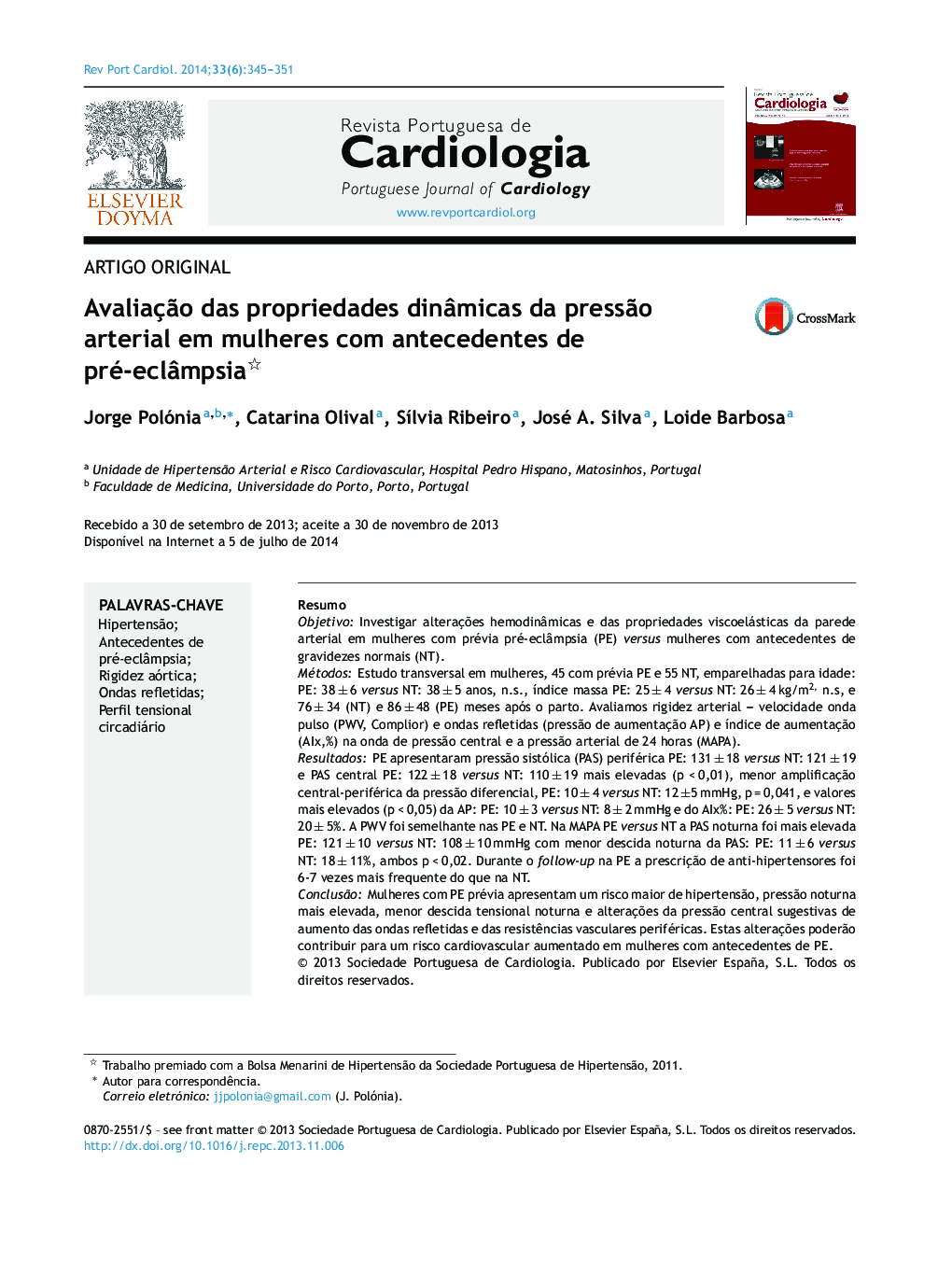| Article ID | Journal | Published Year | Pages | File Type |
|---|---|---|---|---|
| 1125931 | Revista Portuguesa de Cardiologia | 2014 | 7 Pages |
ResumoObjetivoInvestigar alterações hemodinâmicas e das propriedades viscoelásticas da parede arterial em mulheres com prévia pré‐eclâmpsia (PE) versus mulheres com antecedentes de gravidezes normais (NT).MétodosEstudo transversal em mulheres, 45 com prévia PE e 55 NT, emparelhadas para idade: PE: 38 ± 6 versus NT: 38 ± 5 anos, n.s., índice massa PE: 25 ± 4 versus NT: 26 ± 4 kg/m2, n.s, e 76 ± 34 (NT) e 86 ± 48 (PE) meses após o parto. Avaliamos rigidez arterial – velocidade onda pulso (PWV, Complior) e ondas refletidas (pressão de aumentação AP) e índice de aumentação (AIx,%) na onda de pressão central e a pressão arterial de 24 horas (MAPA).ResultadosPE apresentaram pressão sistólica (PAS) periférica PE: 131 ± 18 versus NT: 121 ± 19 e PAS central PE: 122 ± 18 versus NT: 110 ± 19 mais elevadas (p < 0,01), menor amplificação central‐periférica da pressão diferencial, PE: 10 ± 4 versus NT: 12 ±5 mmHg, p = 0,041, e valores mais elevados (p < 0,05) da AP: PE: 10 ± 3 versus NT: 8 ± 2 mmHg e do AIx%: PE: 26 ± 5 versus NT: 20 ± 5%. A PWV foi semelhante nas PE e NT. Na MAPA PE versus NT a PAS noturna foi mais elevada PE: 121 ± 10 versus NT: 108 ± 10 mmHg com menor descida noturna da PAS: PE: 11 ± 6 versus NT: 18 ± 11%, ambos p < 0,02. Durante o follow‐up na PE a prescrição de anti‐hipertensores foi 6‐7 vezes mais frequente do que na NT.ConclusãoMulheres com PE prévia apresentam um risco maior de hipertensão, pressão noturna mais elevada, menor descida tensional noturna e alterações da pressão central sugestivas de aumento das ondas refletidas e das resistências vasculares periféricas. Estas alterações poderão contribuir para um risco cardiovascular aumentado em mulheres com antecedentes de PE.
BackgroundWe investigated viscoelastic properties of the arterial wall in women with previous preeclampsia (PE) compared to those with normal pregnancy (NP).MethodsIn a cross‐sectional study 45 women with previous PE and 55 with NP were included, matched for age (PE 38±6 vs. NP 38±5 years, NS) and body mass index: (PE 25±4 vs. NP 26±4 kg/m2, NS) studied, respectively, 76±34 and 86±48 months after delivery. We assessed arterial distensibility – pulse wave velocity (PWV, Complior) and reflected waves (augmentation pressure [AP], mmHg) and augmentation index (AIx) – in the central pressure wave and blood pressure (BP) on 24‐h ambulatory BP monitoring (ABPM).ResultsPE showed higher (p<0.01) peripheral systolic blood pressure (SBP): PE 131±18 vs. NP 121±19, and central SBP: PE 122±18 vs. NP 110±19 mmHg, with less amplification of central‐peripheral pressure: PE 10±4 vs. NP 12±5, p=0.041, and higher (p<0.05) AP: PE 10±3 vs. NP 8±2, and AIx: PE 26±5 vs. NP 20±5 mmHg, but PE and NP did not differ in pulse wave velocity. On ABPM, PE (n=39) vs. NP (n=33) had higher nighttime SBP: PE 121±10 vs. NP 108±10 mmHg and lower percentage nocturnal SBP fall: PE 11±6 vs. NP 18±11%, both p<0.02. During follow‐up, the need for antihypertensive medication was seven times higher in PE than in NP.ConclusionWomen with previous PE have a greater risk of hypertension, higher nighttime BP values, blunted nocturnal BP fall and changes in central pressure suggestive of increased reflected waves and peripheral vascular resistance. These factors may contribute to their higher cardiovascular risk after pregnancy.
